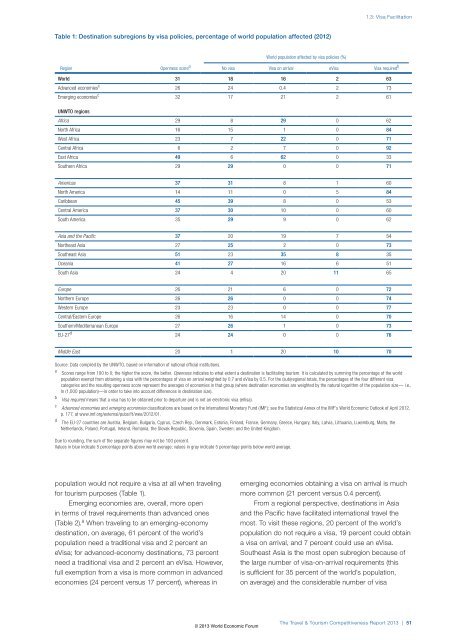The Travel & Tourism Competitiveness Report 2013
The Travel & Tourism Competitiveness Report 2013
The Travel & Tourism Competitiveness Report 2013
Create successful ePaper yourself
Turn your PDF publications into a flip-book with our unique Google optimized e-Paper software.
Table 1: Destination subregions by visa policies, percentage of world population affected (2012)<br />
Region Openness score a<br />
population would not require a visa at all when traveling<br />
for tourism purposes (Table 1).<br />
Emerging economies are, overall, more open<br />
in terms of travel requirements than advanced ones<br />
(Table 2). 8 When traveling to an emerging-economy<br />
destination, on average, 61 percent of the world’s<br />
population need a traditional visa and 2 percent an<br />
eVisa; for advanced-economy destinations, 73 percent<br />
need a traditional visa and 2 percent an eVisa. However,<br />
full exemption from a visa is more common in advanced<br />
economies (24 percent versus 17 percent), whereas in<br />
World population affected by visa policies (%)<br />
1.3: Visa Facilitation<br />
No visa Visa on arrival eVisa Visa required b<br />
World 31 18 16 2 63<br />
Advanced economies c<br />
26 24 0.4 2 73<br />
Emerging economies c<br />
32 17 21 2 61<br />
UNWTO regions<br />
Africa 29 8 29 0 62<br />
North Africa 16 15 1 0 84<br />
West Africa 23 7 22 0 71<br />
Central Africa 6 2 7 0 92<br />
East Africa 49 6 62 0 33<br />
Southern Africa 29 29 0 0 71<br />
Americas 37 31 8 1 60<br />
North America 14 11 0 5 84<br />
Caribbean 45 39 8 0 53<br />
Central America 37 30 10 0 60<br />
South America 35 29 9 0 62<br />
Asia and the Pacific 37 20 19 7 54<br />
Northeast Asia 27 25 2 0 73<br />
Southeast Asia 51 23 35 8 35<br />
Oceania 41 27 16 6 51<br />
South Asia 24 4 20 11 65<br />
Europe 26 21 6 0 72<br />
Northern Europe 26 26 0 0 74<br />
Western Europe 23 23 0 0 77<br />
Central/Eastern Europe 26 16 14 0 70<br />
Southern/Mediterranean Europe 27 26 1 0 73<br />
EU-27 d<br />
24 24 0 0 76<br />
Middle East 20 1 20 10 70<br />
Source: Data compiled by the UNWTO, based on information of national official institutions.<br />
a<br />
Scores range from 100 to 0; the higher the score, the better. Openness indicates to what extent a destination is facilitating tourism. It is calculated by summing the percentage of the world<br />
population exempt from obtaining a visa with the percentages of visa on arrival weighted by 0.7 and eVisa by 0.5. For the (sub)regional totals, the percentages of the four different visa<br />
categories and the resulting openness score represent the averages of economies in that group (where destination economies are weighted by the natural logarithm of the population size— i.e.,<br />
ln (1,000 population)—in order to take into account differences in destination size).<br />
b<br />
Visa required means that a visa has to be obtained prior to departure and is not an electronic visa (eVisa).<br />
c<br />
Advanced economies and emerging economies classifications are based on the International Monetary Fund (IMF); see the Statistical Annex of the IMF’s World Economic Outlook of April 2012,<br />
p. 177, at www.imf.org/external/pubs/ft/weo/2012/01.<br />
d<br />
<strong>The</strong> EU-27 countries are Austria, Belgium, Bulgaria, Cyprus, Czech Rep., Denmark, Estonia, Finland, France, Germany, Greece, Hungary, Italy, Latvia, Lithuania, Luxemburg, Malta, the<br />
Netherlands, Poland, Portugal, Ireland, Romania, the Slovak Republic, Slovenia, Spain, Sweden; and the United Kingdom.<br />
Due to rounding, the sum of the separate figures may not be 100 percent.<br />
Values in blue indicate 5 percentage points above world average; values in gray indicate 5 percentage points below world average.<br />
© <strong>2013</strong> World Economic Forum<br />
emerging economies obtaining a visa on arrival is much<br />
more common (21 percent versus 0.4 percent).<br />
From a regional perspective, destinations in Asia<br />
and the Pacific have facilitated international travel the<br />
most. To visit these regions, 20 percent of the world’s<br />
population do not require a visa, 19 percent could obtain<br />
a visa on arrival, and 7 percent could use an eVisa.<br />
Southeast Asia is the most open subregion because of<br />
the large number of visa-on-arrival requirements (this<br />
is sufficient for 35 percent of the world’s population,<br />
on average) and the considerable number of visa<br />
<strong>The</strong> <strong>Travel</strong> & <strong>Tourism</strong> <strong>Competitiveness</strong> <strong>Report</strong> <strong>2013</strong> | 51

















